|
Radzilow is located only 9 miles NNE of
Jedwabne. It is mentioned quite often throughout the Yizkor Book, and I've
chosen some of those references to highlight here.
I have additional information and records for many Jedwabne
Jewish families.
There were also many marriages between
residents of Radzilow and Jedwabne,
and you may have branches in Radzilow you don't know about. Please
contact me if you
are from this area. |
|
|
|
|
|
|
| My deep appreciation to Rabbi Jacob L. Baker,
the author of Yedwabne: History and Memorial Book, for granting me
permission to reprint some of the sections which mention Radzilow. Note that
all spellings in the portions reprinted here are written exactly as they
appear in the Yizkor Book. You will find Radzilow (highlighted in bold
throughout the text) written several different ways. To read the entire
English section of the Yedwabne Yizkor Book,
click here. |
|
|
|
|
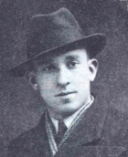
|
|
Eliezer Piekarz
[Rabbi Jacob Baker]
Jedwabne, 1936 |
|
|
|
|
|
|
|
|
|
|
|
|
The
Destruction of the Beautiful Synagogue and the City of Yedwabne in 1913
(Pages 9-10):
|
|
|
|
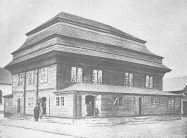
|
|
The Old Wooden Shul
in Jedwabne |
|
| |
|
All those who remember the Old Wooden
Shul in Yedwabne, find that there are no words to describe the beauty of the
structure, inside and outside. It was praised by many periodicals of that time.
From the Archives of Poland we learn that the Synagogue was already in existence
in the year 1771. That was the year it was expanded. Therefore, it is believed
that the original Synagogue was built when the first group of Jews from Tykocin
moved to Yedwabne in the year 1660. In September of 1913, a fire started in a
barn, burned three quarters of the homes of Yedwabne to the ground and
completely destroyed the beautiful Synagogue and its precious books.
|
|
|
|
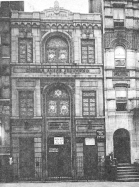
|
|
Exterior of Congregation per Israel Anshe Yedwabne, NYC,
built in 1925 |
|
|
| |
|
A woman was milking her cow by the light
of a candle. The candle toppled over and set fire to the straw in the barn.
Instead of immediately using the milk to put out the blaze, she ran to the house
for a bucket of water. By the time she returned, the fire had already engulfed
many houses and reached the Synagogue, where were stored tanks of naphtha used
for the hanging lamps. The wind then carried the flames through the entire
community.
Rabbi Eliyahu Winer, the Rabbi of
Yedwabne, was visiting his son in the United States. When he heard the terrible
news, he immediately called a mass meeting at the Synagogue of Yedwabne in New
York for the purpose of raising funds to help the sufferers. With the assistance
of Pinchas Turberg and his father-in-law, the famous orator Tzvi Hirsh Maslansky,
Rabbi Winer accumulated an enormous sum of money that was forwarded to Yedwabne.
In the newspaper Hatzfirah of September
17th, 1913, Z. Tasmovsky writes that a request for assistance was sent to the
neighboring cities of Shtucin, Wisna, Radzilowa, Lomza, Suwalk and Grodno.
The appeal stated, "During the night of September 17th, three fourths of the
community, including the beautiful Synagogue and its precious books, was
destroyed within two hours. People ran from their homes without shoes or proper
clothing. Hundreds are in the streets, without shelter, shivering from cold,
hungry and thirsty. The more fortunate found shelter in the pits in the fields
.. . Families of means are now totally impoverished. Those who had little, now
have nothing They walk about with pale faces begging for food and clothing. Now,
winter approaching, we fear the danger of an epidemic of cold weather diseases.
Something has to be done before it is too late.
Signed: Rabbi Eliyahu Winer
R. Yaacov, the son of Shmaryahu Brams
Yonah, the son of Yitzchok Tikucinsky".
Most of the above-mentioned cities
answered with some help, but the city of Lomza, so close to us and with whom
Yedwabne had business connections had not done a thing until a small group of
noble people formed an organization and undertook to help us with cash. They
also lowered the cost of building material for the reconstruction of the many
houses that were burned in the fire in Yedwabne.

|
|
|
|
My Recollections
of the Yedwabner Shul in New York City, By: Ralph Tish, Sec'y Chevra Per Israel
of Yedwabne in New York City (Pages 14-15):
I remember my father taking me to
shul when the Chevra were tenants of the Stutziner-Graevo Shul about 1917.
We occupied the street level floor of the building located at 242 Henry
Street. That was where I was Bar Mitzvaed.
|
|
|
|
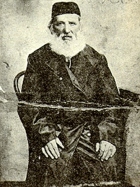
|
|
Ralph Tish's grandfather was Boruch Itzchok Bejnsztejn,
Dayan of Radzilow
Died in Radzilow, 1910 |
|
| |
|
|
|
|
|
 |
|
Ralph Tish, NY, 1945 |
|
|
| |
|
The Tish family had their regular
seats which was the first large bench to the left of the Bima. My father
was the envy of all the landsleit. His entire brood of seven sons traipsed
into Shul and we as children carried on like small children would,
mischievously.
Occasionally my father would take us to
the Redzilover Shul on Division Street near Montgomery Street. That was
where my mother's family came from. [The Bejnsztejn family goes back to at least
the mid-1700's in Radzilow documents.] Radzilova was a close neighbour,
some 15 kilometers from Yedwabne, Poland.
I recall that in 1922 when the
Yedwabner were housed in their own Shul located at 216 Henry Street, my
oldest brother had graduated from medical school and my father gave a
kiddush for the landsleit and my brother was called up to the Torah on
that Saturday and recited the Haftorah. It was one of the highlights at
that time to have a professional man in their midst.
In 1926 we moved out of the East
Side to East New York, Brooklyn and my affiliation ceased, however my
father continued to attend all the meetings of the Chevra and was on many
committees.
I recall attending in 1935, the
50th year anniversary banquet. It was a lavish affair and the committee
was commended for a wonderful job they did.

|
|
|
|
Mr. Kalman Lasky Reminisces, By: Kalman Lasky (Page 15):
I was born and raised in Radzilovo
which is situated about 15 kilometers from Yedwabne. During my childhood years
which were in the beginning of the century. Yedwabne as well as Radzilovo
was burned a number of times.
|
|
|
|
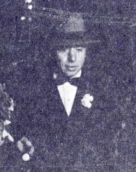 |
|
Kalman Lasky, NY |
|
|
| |
|
I recall, evenings when everyone was
looking out to the horizon pointing to Yedwabne. If the sky reddened, this was a
certain sign that our neighboring shtetel Yedwabne is G-d forbid, burning.
The Radzilovo Jewish community
came to their assistance at once, by first loading full wagons of loaves of
bread and other immediate necessities which were dispatched quickly to the "Nisrofeem"
(burned out people) of Yedwabne.
The same was vise-versa. Yedwabner Jewish
people looked to our horizon and when they noticed it red they knew that
Radzilovo is in trouble, so they quickly came to our assistance.
The reason for the oft burnings was due
to the straw roofs on most of the dwellings in the shtetel.
These childhood reminiscences about such
true devotion between the two towns Radzilovo and Yedwabne, must have
been the main reason why I joined the "Chebra Par Israel Anshe Yedwabne", and I
am honored to be its active president for the past number of years.

|
|
|
|
Yedwabne Nickname - Krichers (Trudgers), By: Eliezer (Pages 20-21):
Every city or town surrounding us, for one reason or another, acquired a
nickname. For instance, at the weekly market-day on Wednesday, when almost every
comer in Yedwabne was filled with businessmen from everywhere, you could hear
adjectives for each town's-folks, such as, "Lomzer Baallonim" (Prospectors),
"Radzilover Kozes" (Goats), "Kolner Pekelach-Pekewach" (Packages) and "Yedwabner
Krichers" (trudgers).

|
|
|
|
Great Yedwabne Legend, By: Itzchok Yankel Neumark (Pages 52-54):
IN RESPONSE TO OUR REQUEST, TO EXPLAIN A
GREAT YEDWABNE LEGEND THAT AS A YOUNG BOY, HE SAVED 60 PROMINENT JEWS FROM THE
GALLOWS, ITZCHOK YANKEL NEUMARK RECORDS HIS OUTSTANDING AND HEROIC ACTION IN THE
YEAR 1920. THE BLESSINGS FROM THE 10 RESCUED RABBIS BROUGHT HIS OWN SALVATION
DURING THE ENTIRE HITLER HOLOCAUST PERIOD.
|
|
|
|
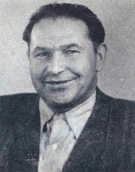
|
|
Itzchok Yankel Neumark
After Liberation, 1945 |
|
| |
|
It was a short time after my Bar-Mitzvah,
in the year 1920, when the Polish army shattered and chased the Germans from the
Polish soil.
The notorious anti-semite, General Haller
decided to crown his triumph against the Germans by celebrating a pogrom against
the Jews of Poland.
In Haller's army were then enrolled the
most notorious anti-semites who, unconscionably plundered, beat, and murdered,
tore out beards, and threw Jewish men, women and children from trains.
On the eve of Yom Kippur the Hallerites
killed a gentile and hid the body under the house of the Rabbi of Radzilovo,
which was situated 16 kilometers from Yedwabne. Afterwards they let pigs out
from their stys to uncover the body. They immediately spread a rumor that the
Rabbi had murdered the man and thus called publicly to take revenge from the
Jews at once - by arresting 10 Rabbis and 50 Community leaders from the towns
surrounding Radzilovo and publicly executing them all. They arrested the
following towns' Rabbis: Radzilovo, Yedwabne, including Reb Faivele,
Stavisk, Grayeevo, Raigrod, Goniondz, etc., together with the laymen, 60 people.
The Radzilover Rabbi knew
personally the arch-bishop of Lomza for he had previously saved the life of the
arch-bishop from the Russians. He was the only one who might have an impression
on the anti-semites and therefore could save the 60 lives. The problem was,
though, how to reach him in a time when all the roads to Lomza were fenced out
by Haller's men.
The Radzilover Rabbi wrote a
letter to the arch-bishop which was signed by all the Rabbis. But they still
needed an able young horse rider to carry out the most dangerous undertaking of
delivering the letter into the hands of the arch-bishop in Lomza, and in the
quickest possible time, for the execution was scheduled for the next 1 A.M.
Then a delegation of the following
community leaders came to me: Sholom, Hershl Mendl's Shtein, Avrom Aaron Ibram,
Chonche Goldberg, Chone Zaidenstat. They pleaded that I undertake to be the
messenger. Although I was much afraid, for I understood the serious danger that
awaited me on the roads, the thought and deep conviction that I was thereby
going to save such great Zadikim (righteous people) and Chasidim (of highest
generosity) put me at peace. So I accepted, donned a gentile type hat, borrowed
my gentile neighbor's horse (my own horse had conspicuous brown coloring) and as
an arrow I flew until I reached Piontnica. A Hallerite noticed me and tried to
restrain me, but I escaped from him and arrived in Lomza.
I then saw what the anti-semites do to
the Jews. Near the old church lay dead Reb Yochanan, the salami maker, further
on Zondova Street the vinegar maker lay dead. Near the old market place in the
gutter was the candlestick maker's corpse. I then went to the Rabbinate in order
to inform them of my message. Their faces were all covered with black shawls for
the Hallerites had their beards torn out until blood; they all wept. They
wondered how I made my way in such a terrible time. But they blessed me that no
evil shall come to me and that I shall carry through my whole message in peace.
Since the Lomza streets were then empty
of people, I took courage and quickly rode to the Dvorna Street to the residence
of the arch-bishop. When I knocked on the door a nun came out and asked me what
I wanted. I informed her that I had a letter to the Holy father which I had to
hand over to him personally. Then came out a priest who requested that I hand
him the letter. I refused, explaining that I'm forced to hand the letter
personally to the arch-bishop for the Hallerites were about to shoot many
righteous Polish people. He then allowed me in, where the Archbishop dressed in
a purple, gold covered vestment accepted the letter from me. Immediately after
he read the letter he wrote a letter which he quickly sent out with his special
messenger (all the phones were then cut off). He then bid me farewell and said
everything will be all-right. The arch-bishop's messenger reached the
destination 20 minutes before the execution of the 60 people was to take place.
I immediately rode back to Yedwabne in
order to be home for Yom Kippur. Until midway, which was the village of Yezurk,
I saw no one. But within the village I was held up by a Hallerite, and while
they were searching for a cord to tie me to the horse and then let him run while
dragging me on the ground to death, I utilized that moment to jump up on the
horse and quickly escape, galloping towards my home town. The Hallerites pursued
after me while shooting, but I made my way to come home healthy in body and
spirit, although my horse had been shot through the ear. The Jewish people
greeted me with hugging and kisses. They wanted to pay me for my heroic
accomplishment, but I told them that such a Mitzvah they may never buy for
money.
After the Shovuos Holiday, there arrived
to Yedwabne a full bus of Rabbis in order to meet me and to convey their
gratitude and blessings upon me. Then someone disguised made believe that he was
the one who carried through the message, but when he was questioned to give the
details, he immediately admitted and pointed to me as being the true messenger.
After a brief exchange of words with me on the details of the entrance to the
Bishop's residence, etc., the Zadik of Radzilova took my hands in his
and said the following prayer: "Through fires and waters, though thunders and
lightning, nothing shall ever touch you." There after did all the other Rabbis,
one after the other bestow their blessings upon me.
I truly believe and whole heartedly that
in virtue of their blessings I was saved, first from the flaming barn in
Yedwabne, and later through 5 ½ years in the most dangerous concentration camps.
Thank G-d I always came through without
even a scratch - so shall the Heavenly Father continue to help me and my family
in virtue of the Righteous People's Blessings and we shall all live to see the
coming of the Messiah who will bring Peace to Israel and to the entire world.
Amen! So be his will.

|
|
|
|
The Pilgrimage, By: Rabbi Julius L. Baker (Pages 71-76):
. . . On our return we stopped in the
city of Lomza, where I spent many years learning in the famous Talmud Torah and
Yeshiva. I walked through the streets with the hope of finding some trace of
Jewish existence there. To my sorrow, I found only the distinctive bricks of the
beautiful synagogue built into a garage on Dluga Street.
All the cities and towns through which we
drove had totally destroyed every trace that might show Jews had lived for
hundreds of years among the inhabitants, and had also considered themselves as
Poles. Everything looked very alien to me.
From, Lomza we drove the 21 kilometers to
Yedwabne in about 15 minutes. During my youth I walked quite often from Yedwabne
to Lomza and back. I knew every village and its people. Many Jews of Lomza were
murdered in those villages during the Second World War.
As we approached the outskirts of
Yedwabne, I recognized every building we passed. And I recalled every Jewish
family that had lived in those buildings. And now they were occupied by the
Polish murderers. We drove past the house that belonged to the Zelenitz Family,
and it brought back many memories of the happy days when I was a young boy. On
the opposite side had stood the remains of the famous wooden Synagogue (it had
burned down before the First World War), and the Bet Hamedrash, the
Chevra-Tehilim, the Chevrah Bachuriin. And now we passed an empty lot.
We drove through the market place, where
the Magistrate still existed. The structures and stores belonging to Jewish
merchants were now occupied by non-Jews. We turned towards the road to Pshitula.
We passed the old water well, the house that belonged to Shirke-Reizel Tzinowitz,
and her big garden. We drove by an orchard that belonged to the priest, and
Shilaviuk's house in front of which was a waterwell. I recognized Franek
Shilaviuk - he ran into the house. He must have recognized me and feared an
encounter. He was one of the chief murderers of the Jews of Yedwabne. There were
witnesses to his killing of my Uncles Pecinowitz (the millers) and their
families. May G-d avenge their blood !
We continued to the city of Radzilovo,
passing the Zaganik (small forest), and many familiar villages. Even in this
area there was left no indication whatsoever of the many Jewish families that
had lived in its soil. On our return we again passed Yedwabne and drove to the
cemetary. Near this area were burned alive all the Jews of Yedwabne and many
from the cities of Radzilowa and Wizna on that fateful day of July 10,
1941. For almost two hundred years our ancestors were buried in that cemetary.
Now, not one tombstone could be seen. Our neighbors, the Poles, had plowed under
even the remains of dead Jews. We returned to Warsaw that evening physically and
emotionally broken.
The following day we went to the Praga
Cemetary near Warsaw. My Father of blessed memory, was buried there when he died
in Warsaw during the Bolshevik-Polish War of 1920-21. There too, we could find
no sign of a grave.
I had been steadfast in my belief in man.
Suddenly, my ties were cut. My past was a memory only for me. Wherever I looked
for the known, for the familiar, I found only emptiness. To stop the terrible
depression which was overcoming me from every direction I had to get out of
Poland as quickly as possible. I needed the comfort of my own people around me
to regain my stability.
We left Poland for a very brief visit in
Copenhagen. The dreary weather, the lack of all we needed for our Jewish souls
shortened that stay. On we flew to London, where kindness from friends and sunny
weather helped us over the weekend. And on Monday we boarded the plane for the
United States of America and home.

|
|
|
|
The Destruction of the Jewish Community of Yedwabne, Poland, By: Rabbi Julius L.
Baker (Pages 87-89):
Deaf were the heavens to the screams of
agony of our unfortunate brethern who were tormented and then killed in the most
vicious manner that has no equal. Dulled were the brains and hearts of the
Gentile neighbors of Yedwabne, when they perpetrated such violence against our
loved ones, who were a defenseless minority in their midst, and finally burned
them alive.
The curse of G-d rests upon the filthy
earth of Yedwabne. Nothing remains of its Jewish community. The courtyard of the
old synagogue is no longer there. The Bet Hamedrash, the house of learning and
prayer which was located in the midst of the city and was partly destroyed after
the Jews were murdered, has been totally wiped out by the order of the city
government. In its place they built dwellings that are now occupied by the
murderers of our people. Among the Jews of Yedwabne were manufacturers,
businessmen, public officials, social workers, and many scholars, both secular
and Torah.
The Jewish community came into being two
to three hundred years ago, and it ended with the beginning of the destruction
of all Jewish presence in Poland. The Jews of Yedwabne were the first to be
burned alive - because they were Jews. This was the accomplishment of the
Gentile neighbors, the depraved and the defilers of humanity, with the
permission of the Nazis, the monsters of history.
I feel it is my duty to do the Mitzvah of
Kibud Av V'Em, honoring parents, grandparents, relatives and friends, by
ensuring that the memory of these beloved ones remains with us forever. The
horrible day of the 15th of Tamuz, 5701, corresponding to July 10th, 1941, must
be made known to the world. The names of the murdered Yedwabne Jews must be
added to the large list of the thousands of Jewish communities that existed
before the Holocaust, and have been memorialized in books. The descendents of
Yedwabne have tarried too long. In other cities, like Kolno, a common grave
still exists as a memorial to the holy martyrs. Only in Yedwabne was there not
even an indication that a Jewish community ever existed.
Yedwabne had famous Rabbis, Chazanim,
Shochtim, Melamdim, world-renowned schools, modem teachers, and charity
institutions. It was a thriving, lively place for and because of our people.
Therefore it is frightful that not a word was mentioned in the newspapers of
that time on the exact occurrences of that dreadful day of the destruction of
the Yedwabne Jewish community. We can find only small paragraphs here and there.
One is written by a woman from the Nilowicki family of Wizno, who came to
Yedwabne for refuge. She, like many others thought this might be a safe place. A
woman of the Finkelstein family of Radzilows, near Yedwabne, related
that after the war was over, she was in Yedwabne and saw goyim occupying former
Jewish homes. The children were dressed in clothes that had been worn by Jewish
children. Through a window of Sorchie's bakery she saw some Jews and one was
wearing a piece of yellow cloth on his arm. He told her that he worked in the
food storage house in what had been the synagogue. He related also that the few
remaining Jews suffered greatly because of the converted Jew, Israel Grondowski,
who told lies about them to the anti-Semitic Polish gangs.
The son-in-law of the Shochet and Chasid,
Dovid Nishtzonski from Radzilovo, at that time worked in Yedwabne. His
wife and children refused to leave their father and grandfather, the Tzadik,
alone in Radzilovo, so they remained with him. The wife wrote a note to
her husband telling him that his being in Yedwabne would be worse than hers. She
then wrote to someone else that only twenty Jews remained in that city by the
end of November, when they too were sent to the extermination areas together
with those from the Jewish Ghetto of Lomza.
A woman by the name of Rivke Kaizer from
Wizno escaped from the market place in Yedwabne. In the Memorial Book of the
city of Sokola, printed in Tel Aviv in 1962, she related that after the Churban
of the Jewish community of Tykocin, they got word through escapees from Yedwabne
and Radzilovo, about what had happned there. The goyinm ordered all the
Jews, including the Rabbi and the leaders of the people, to go to the market
place. There they were told to put on their Talaisim and Tfilin, and to dance
and sing. Afterwards they were locked into a big barn near the Jewish cementery.
The barn was then splashed with benzine and ignited. All were burned alive. May
G-d avenge their blood !

|
|
|
|
World War Two Years Remembered, By: Herschel Piekarz Baker (Pages 91-99):
|
|
|
|
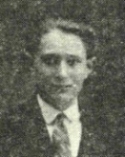
|
|
Hershel Piekarz
Baker
Jedwabne, 1933 |
|
| |
|
. . . On July 14, 1941 my mother
arrived in Goniandz. She had been running through the woods and fields from
Yedwabne to Goniandz and was exhausted. She had been en route for three days and
had escaped the slaughter which the Poles perpetrated on the Jewish community of
Yedwabne. (She was able to escape because she habitually dressed in the manner
of Polish women, spoke Polish without an accent, and could not be recognized as
Jewish.) She related the following: On the preceeding day several wagons arrived
from the surrounding villages. These were to have been used to take the Jews to
concentration camps to work. The Poles, however, decided to kill the Jews right
there. The Poles herded together all the Jews of Yedwabne and some from Wisneh
and
Radzilovo, a total of about fourteen hundred people. The aged Rabbi Avigdor
Byalistotsky stood at their head as they were kept in the marketplace in the
heat of the day. The Poles struck and mercilessly beat whomever they chose. The
Jews were ordered to march along the road to the cemetery; and the Poles drove
them into the barn, locked the doors, poured kerosene over the entire barn and
ignited it. The Poles stood singing and pounding wooden noisemakers to drown out
the piercing cries that emanated from the burning barn -- "Sh'ma Yisroel --" . .
.

|
|
|
|
Jack & Leika
and Their Polish Rescuer Mrs. Antoninia Wyrzykowska, By: Jack Kubran (Pages
106-109):
In 1941, when the war broke out, a panic
started among the Jewish people. All kinds of rumors were spreading throughout
the town.
It was at this time that a Polish friend
of mine came and told me that in the town of Radzilow, all of the Jews
were burned without mercy by the Polaks. I was told that this was precisely what
they planned to do in our town of Yedwabne.
|
|
|
|
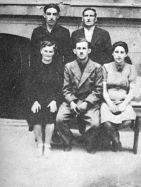 |
|
[Bottom row L-R]: Antonina Wyrzykowska
(Righteous Gentile who saved seven Jews),
Szmul Wasersztajn, Leja Kubrzanska (Kubran);
[Back row L-R]:
Janek Kubrzanski
(Jack Kubran),
unidentified man. |
|
|
| |
|
I came home with this terrible news and
told my parents and others about it. They thought that I was totally crazy.
As it turned out - and regretfully so - I
was not crazy after all. The nightmarish rumor became a reality. I was taken
away by the German military to work for them, while within the town, the
liquidation of the Jews went on.
From every corner of the town, Polish
murderers chased the Jewish people into a large barn. One Pole had the pleasure
of pushing everyone through the doors of the barn to their deaths. They were
burned alive.
My ear drums felt like bursting from the
pitch of human voices screaming and crying in the barn. The smell and smoke of
burning flesh was impossible to take. Knowing that my family was among them made
it even more unbearable.
At this time, the Polaks came to the
Germans for whom I was working and demanded that they release us to the fate of
the buming barn. The Germans refused, preferring to keep us as laborers, but
later changed their minds and let us go. We Jews ran in every direction to
escape the awaiting Polaks, who succeeded in killing many of us. Luck was with
me and I was neither caught nor killed.
I ran to Lomza, a ghetto where a cousin
of mine lived. There, much to my joy, was my father, who had run away from the
fire. It was here, living with my father also, that I met a girl from Sczuczyn
named Leika Amrofel, who was to become my wife. Living with us were Mojszo
Olszewiez from Yedwabne and his wife Elka Sosnowska, also from Sczuczyn.
Mojsze's brother, Berek Olszewiez, shared the household with us as well.
My joy in having found my father was
short-lived, for he was soon to be taken away by the black truck-that ominous
vehicle which used to come into the ghetto, catch people, and take them away,
never to be seen again.
I was crushed. In this atmosphere of not
knowing who would be taken next, life went on. I was taken to work in Zambrow at
the "shteinbrook" during the weekdays, and returned home to join my wife and
friends in the ghetto on the weekends.
One Sunday in 1942, a great panic broke
out in the ghetto. News came that the ghetto would be liquidated and that all
the Jews will be sent to concentration camps. I decided that the time had come
to run. With my wife and many of the other ghetto Jews, we broke the barbed wire
fence and ran into the night in different directions.
We had no idea where to go, but knew with
certainty that we had to find a place to hide before dawn. Without knowing it,
the local farmers became our protectors, for we crawled without their knowledge
under the hay piles in their barns and remained there unnoticed by the Germans
and Polaks.
We realized we had to find another more
safe place. We knew that Szmulek Waserstein was working at the home of a woman
named Antonina Wyrzykowska in Jancewko while we were in the ghetto. I decided to
go to see if Szmulek was still there and if perhaps these people could be of
help to me and my wife. Leaving her hiding in a ditch alone, I traveled during
the nights and hid in the woods by day. After several days, I came upon the farm
to find that Szmulek was still there and that Mojsze, his wife and brother Berek
had run straight there from the ghetto.
Antonina was known to me, for she had
often risked her life by smuggling as much food as she could into the Lomza
ghetto when I was there. Now, I was quite happy to see my friends from the
ghetto there. They had already built two bunkers in the barn, where they could
hide under the floor of the barn with hay covering them and sheep walking above
them. Upon seeing me, Antonina told me to join the others, that she would try to
do for us what she was trying to do for the others and that maybe G-d would help
us all to get through it. My gratitude was overwhelming, and I went to retrieve
my wife so that she could join us.
It is impossible to express what it meant
to us to have a place to stay. During the 28 months in which we were there,
Antonina shared many frightening moments with us. On one occasion, the Gestapo
came to look for us with dogs and poked around with their bayonnets into the
bunkers, but did not discover us. Our safety had been insured by Antonina, who
had poured gasoline around us as soon as she had noticed them coming so that the
dogs would not detect our presence.
Risking her life, the lives of her entire
family, and her farm, this remarkable woman made it possible for the seeming
miracle of Liberation to be one that we could experience.
In 1945, after the liberation, we went
first to Yedwabne. Our lives were again in danger from the A.K., who didn't
believe that Jewish holocaust survivors should exist. We went, therefore, to
Lomza, and from Lomza to Austria.
It was while we were in Austria that I
had the good fortune of finding an uncle in New York who became our sponsor for
our immigration to America in 1949. Having lived for a short time in New York
upon our arrival, we then moved to Hartford, Connecticut, where we settled and
had a family of three children, all of whom are now married.

|
|
|
|
Reports: "The
Burning Alive of the Entire Jewish Community of Yedwabne on July 10, 1941 (15th
of Tamuz 5701), By: Itzchak Yaacov (Yanek) Neumark (Pages 111-116):
. . . When the Germans attacked the
Russians in the year 1941, many Jews ran to Russia. I couldn't do it for I had
to care for my aged father and a sister with a child whose husband was then in
Uruguay. I also had to help my brother's wife and 4 children. My brother was
also in Urugvay.
|
|
|
|

|
|
Itzchok Yankel Neumark
After Liberation, 1945 |
|
| |
|
As soon as the Germans conquered our
section, the Polish goyim of the surrounding villages began planning with them
how to exterminate the Jews. They drove all the Jews of Yedwabne, among them
also were Jews from Wizno, and Radzilova, into the market place and left
them in the burning sun without water to drink. They had there 1440 people
including men, women and children. After merciless beatings and many killings on
the spot, they drove them into a barn belonging to Bronek Shlishenski. Standing
nearby were the known Jew haters : Jack and Stephan Kozlowski, the blacksmith
from Pshestreler Street near the cemetery, the baker Kurlevski, Aurbach and his
son-in-law, and the entire family of the Osetzkes who lived near the barn. With
joyful songs they poured benzene upon the barn and ignited it with the Jews
packed within. At the door stood Stashek Shilaviuk with an ex in his hand ready
to behead anyone trying to escape from the barn. I was standing with my family
at the door, for I had the good luck of being among the last ones forced into
the barn. Suddenly, by the force of the flame, the door opened up and when I saw
Stashek Shilaviuk at the other side of the door ready to hit me with the ax, I
managed to pull the ax from his hands and managed also to take with me my
sister, her five-year-old daughter, and Itzchak Aaron Mendel's son. The latter's
back was already scorched with wounds that never healed. He later perished in
Aushwitz. I could see my father falling burned to the ground. We ran to the
cemetery and lay there till night fell.
In these terrible moments, I noticed that
my sister and her little daughter became totaly gray. In the darkness of the
night I took my sister Esther-Lea and daughter Reizale to the priest of the
village of Pshitul, and I myself hid at the house of the Doctor Kowaltzuk. After
the war I was told that they killed my sister Esther-Lea just two weeks before
the war ended. Someone recognized her as a Jewess. About her daughter Reizale I
could never find a trace. . .

|
|
|
|
|